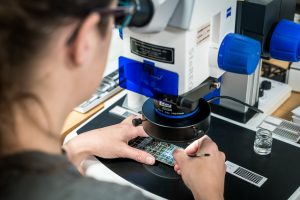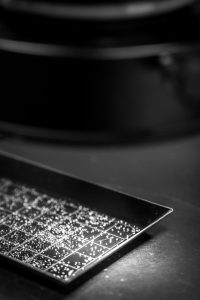Postcards from Scientists – Kirsty Edgar’s secrets from tiny fossils

Ahoy there, I’m Kirsty Edgar, one of the micropaleontologists on IODP Exp. 369. I live in the small market town of Rugby, in the UK (it’s where the game originates!) and currently work as a Lecturer at the University of Birmingham.

Being onboard the ship is great. I have a two-minute commute to work everyday and I don’t have to do any household chores so I just get to do science for twelve hours everyday! I’m one of two planktic foraminiferal micropaleontologists onboard. What that means is that I use a microscope to study the tiny shells of long dead organisms known as foraminifera (smaller than a grain of sand). These are simple, single celled organisms that live in the top several hundred metres of the water column and precipitate a hard shell. When they die their shells fall to the seafloor and are preserved in sediments. The shells are different shapes and each shape represents a different species, many species typically only live for a short time that we can assign an age to. Thus, we can use the pattern of originations and extinctions of these species to figure out the age of sediments over the last 200 hundred million years. This is an important role on the ship as the age is necessary to know how much further to drill, when we’ve hit our targets and to place the sediments that we recover into context.
Whilst many elements of our day are the same, it never gets dull. Every day there’s a new challenge whether it’s from the weather, kit, or just from working in an entirely new area where you have no idea what you are going to find. Also, the feeling on-board when we’re close to recovering an exciting climatic interval is absolutely electric and brings everyone together. Being patient and flexible is key to being happy onboard. To unwind, I watch movies and play a lot of cards with my shift mates merging rules from different countries and inventing new ones!
Photos: Vivien Cumming